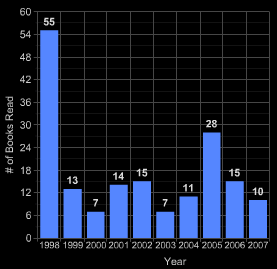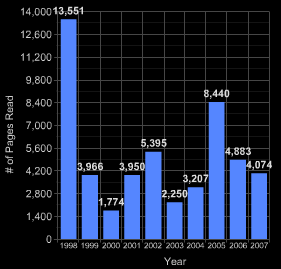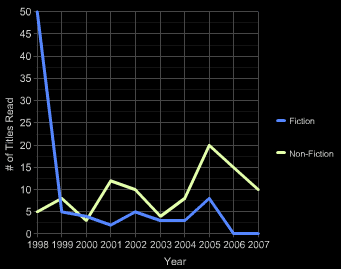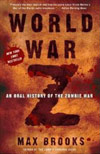There are some things in my life that I’m oddly obsessive about, and one of them is writing down every book that I read; including the author, title, and number of pages. I keep a completely outdated list hidden away online, but also write things down in a little book that’s also caught scribbles, random thoughts, and other ephemera for some time now.
While writing down information for the most recent book I finished, I noticed that I’ve been keeping this data on books that I’ve read for ten years now, and so the small part of my brain that thinks it’s fun to write down these things also thought it would be a good idea to do a little retrospective to try and parse some of the data within.
In looking at the list, there were trends that seemed obvious at first, but upon further examination revealed themselves to be not quite so. When I first started the list, I was fresh out of college and barely knew anyone in the city that I was living in, and I spent a lot of time by myself with my head buried in a book. In the time since then, I met my future wife, joined a band, got a house, got married, gained a couple pets, and changed jobs. Like I said above, though, the data doesn’t completely add up all the time.
Without further ado, here are the first couple charts…
Chart 1: Books read per year

Chart 2: Pages read per year

These first two charts are fairly uneventful, and largely represent the same sorts of trends (duh).
First off, it’s interesting to note that the very first year I started keeping track is also the largest number. As I mentioned above, 1998 was the first full year that I was out of college and on my own. Although I had a very small group of friends, I didn’t have a lot of people that I spent huge amounts of time with. During this year, I also had surgery, and I specifically remember reading not only one, but sometimes two and three books during a single day when I was in recovery.
From there, the trends largely stay fairly similar, although the years 2000 and 2003 show significant dips. The former was the year that I met my future wife, but it doesn’t explain the dip in reading, as I didn’t meet her until later in the year. The lack of reading in that year was probably more explained by finally having a larger group of friends in the town where I was living, as well as more of my time being spent working on photography (I had an independent show that year and often shot 3 rolls of film a week or more). The dip in 2003 is more obvious, as that was the year that we both bought a house and got our first dog (Zoey!).
I have a hard time explaining the spike in reading for 2005, other than knowing that Marianas dissolved in the first half of that year. Most likely, I spent more time reading on many nights rather than practicing music.
Because of my current infatuation with non-fiction titles, I also decided to go back and chart every title that I’ve read over the past 10 years and see how my tastes have evolved in that time as well. In some ways, this information is also the most interesting.
Chart 3: Fiction / Non-fiction titles in the past 10 years

The complete disparity in fiction vs non-fiction in 1998 is easy to explain, as I not only tried to read a good portion of the fiction titles that I’d never been assigned in school (but felt were somewhat essential), but I also got stuck on certain authors (like Ray Bradbury, Harlan Ellison, and Kurt Vonnegut) and then plowed through a good batch of their books in a row.
A trend that holds true with this chart is that in the years where I read a lot more books were also the years that I read a bit more fiction. I’ll be the first to admit that I can read fiction titles a great deal faster than non-fiction, and it makes perfect sense that I’ve slowed down on number of titles the past couple of years (when I haven’t included a single fiction book).
I will also admit that I simply haven’t been as interested in fiction titles the past couple years, mainly because I feel like I gain a bit more from reading non-fiction titles in terms of knowledge. That said, my creative instincts may have suffered a smidgen by cutting out fiction work, and I plan to at least incorporate a couple fiction titles each year from here out.
If I dig a little deeper, I’m sure that there’s some more interesting stuff I can find here, but for now I will simply end with the aggregate numbers.
Books read 1998-2007: 175 (fiction: 80 / non-fiction: 95)
Pages read 1998-2007: 51490






 My wife (and others) have been poking fun at me for some time now about my reading selection, but it wasn’t until I got about halfway through this latest tome when I realized just how weird my book selection has been the past half year or so. I’ve read books about what would happen to the world if
My wife (and others) have been poking fun at me for some time now about my reading selection, but it wasn’t until I got about halfway through this latest tome when I realized just how weird my book selection has been the past half year or so. I’ve read books about what would happen to the world if  When I first read about the concept of
When I first read about the concept of  To some, it would probably be a bit odd that the first book I’ve read by Haruki Murakami is his only non-fiction work, but that’s exactly the route I’ve now taken. While my wife has managed to read a good portion of his fiction work, I’ve continued on my non-fiction binge that started last year and shows no sign of letting up. Oddly enough,
To some, it would probably be a bit odd that the first book I’ve read by Haruki Murakami is his only non-fiction work, but that’s exactly the route I’ve now taken. While my wife has managed to read a good portion of his fiction work, I’ve continued on my non-fiction binge that started last year and shows no sign of letting up. Oddly enough,  As is probably completely apparent by now, I’m a really big fan of Studs Terkel. Over the course of the past couple years, I’ve read just about every book of his collected interviews that he has released to date. Of these, I would have to say that Working,
As is probably completely apparent by now, I’m a really big fan of Studs Terkel. Over the course of the past couple years, I’ve read just about every book of his collected interviews that he has released to date. Of these, I would have to say that Working,  I’m not even sure where I stumbled across this book, but for some reason it seemed really intriguing and I ended up purchasing it on a whim and deciding that it would be the next book that I’d read. As I’ve mentioned many, many times before on this site, I’m kind of an idiot when it comes to history, so I figured this book would help to fill in a few more gaps in knowledge for me.
I’m not even sure where I stumbled across this book, but for some reason it seemed really intriguing and I ended up purchasing it on a whim and deciding that it would be the next book that I’d read. As I’ve mentioned many, many times before on this site, I’m kind of an idiot when it comes to history, so I figured this book would help to fill in a few more gaps in knowledge for me. I’m not sure where I stumbled across reading about this book, but somewhere along the way during the past two months it found its way onto my Amazon wishlist and finally into my personal library. Originally written back in the 1940s,
I’m not sure where I stumbled across reading about this book, but somewhere along the way during the past two months it found its way onto my Amazon wishlist and finally into my personal library. Originally written back in the 1940s,